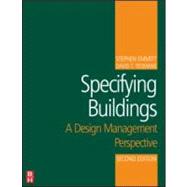
Note: Supplemental materials are not guaranteed with Rental or Used book purchases.
Purchase Benefits
Looking to rent a book? Rent Specifying Buildings : A Design Management Perspective [ISBN: 9780750684507] for the semester, quarter, and short term or search our site for other textbooks by Emmitt; Yeomans. Renting a textbook can save you up to 90% from the cost of buying.
| Specifications in context | p. 1 |
| A historical note | p. 3 |
| Specification research | p. 6 |
| Learning to specify | p. 7 |
| A framework for specifying | p. 9 |
| Consequences | p. 13 |
| Terms, definitions and scope of the book | p. 13 |
| Specifying design intent | p. 16 |
| Coordinated project information | p. 18 |
| Specification methods | p. 24 |
| Case study: Using proprietary and performance approaches | p. 35 |
| End of chapter exercises | p. 37 |
| Information sources | p. 38 |
| Regulations | p. 40 |
| Standards and Codes of Practice | p. 42 |
| Trade associations | p. 44 |
| Testing and research reports | p. 46 |
| Manufacturers' information | p. 48 |
| Manufacturers' trade representatives | p. 55 |
| Touching the product | p. 57 |
| End of chapter exercises | p. 59 |
| The selection process | p. 60 |
| Contributors to the specification process | p. 61 |
| Detail design decision making | p. 67 |
| Product selection criteria: fitness for purpose | p. 73 |
| End of chapter exercises | p. 83 |
| Writing specifications | p. 84 |
| Writing the specification | p. 87 |
| Standard formats | p. 91 |
| Specification language | p. 94 |
| Clarity, brevity and accuracy | p. 96 |
| Typical contents of a written specification | p. 98 |
| End of chapter exercises | p. 105 |
| Managing the specification process | p. 106 |
| The specifier's milieu | p. 107 |
| Office standards and masters | p. 110 |
| The master specification | p. 112 |
| Project specifications | p. 114 |
| Design reviews and coordination | p. 116 |
| Value management | p. 119 |
| Design control during the realization phase | p. 120 |
| Resource allocations | p. 126 |
| End of chapter exercises | p. 131 |
| Specifying 'new' building products | p. 133 |
| New ideas and products | p. 133 |
| Innovation | p. 134 |
| Diffusion of innovations research | p. 142 |
| The innovation decision process | p. 146 |
| Research methodology | p. 148 |
| Becoming aware of new products | p. 152 |
| Early clues | p. 152 |
| Prior conditions | p. 155 |
| The knowledge stage | p. 157 |
| What specifiers want and how they behave | p. 160 |
| Marketing | p. 164 |
| Outside influences | p. 168 |
| Product characteristics | p. 169 |
| Monitoring the specification of buildings | p. 174 |
| Two gates | p. 175 |
| The specification of 'new' building products | p. 178 |
| Contributing factors | p. 183 |
| Implications | p. 186 |
| Observing specifiers | p. 188 |
| Specifier A | p. 189 |
| Specifiers B and C | p. 196 |
| Specifiers D and E | p. 200 |
| Discussion | p. 204 |
| Design management issues | p. 206 |
| Implications | p. 207 |
| Towards best practice | p. 209 |
| A model of the specifier's decision making process | p. 210 |
| Research matters | p. 215 |
| Establishing and maintaining best practice | p. 218 |
| Common problems and practical suggestions | p. 223 |
| Future directions | p. 225 |
| References | p. 228 |
| Postal questionnaire results and commentary | p. 235 |
| Index | p. 251 |
| Table of Contents provided by Ingram. All Rights Reserved. |
The New copy of this book will include any supplemental materials advertised. Please check the title of the book to determine if it should include any access cards, study guides, lab manuals, CDs, etc.
The Used, Rental and eBook copies of this book are not guaranteed to include any supplemental materials. Typically, only the book itself is included. This is true even if the title states it includes any access cards, study guides, lab manuals, CDs, etc.